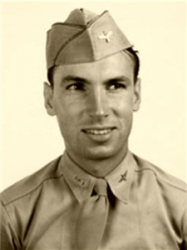
 |
|
|
||
|
Raymond Larry Knight |
||||
|
Engagements: • World War II (1941 - 1945) |
||||
| Biography: | ||||
|
Raymond Larry Knight First Lieutenant Raymond Larry Knight (15 June 1922 - 25 April 1945) was a U.S. Army Air Forces officer and pilot who was posthumously awarded the U.S. military's highest award for valor, the Medal of Honor, for his actions during World War II. Raymond Larry Knight was born on 15 June 1922 in Timpson, TX. He joined the U.S. Army Air Forces from Houston, TX. On 24 April 1945, he was a First Lieutenant piloting a P-47 Thunderbolt aircraft. In the northern Po Valley of Italy that day, he repeatedly volunteered to lead attacks on enemy air bases and exposed his aircraft to intense hostile fire in low-altitude reconnaissance and strafing missions. During a mission on 25 April, his airplane was badly damaged by anti-aircraft fire. Knowing that his unit was short on aircraft, he chose not to bailout and attempted to fly the Thunderbolt back to his home airbase. However, he crashed in the Apennine Mountains and was killed. For these heroic actions, he was posthumously awarded the Medal of Honor. Medal of Honor Rank and organization: First Lieutenant, U.S. Army Air Corps. Place and date: In Northern Po Valley, Italy, 24-25 April 1945. Citation: He piloted a fighter-bomber aircraft in a series of low-level strafing missions, destroying 14 grounded enemy aircraft and leading attacks which wrecked 10 others during a critical period of the Allied drive in northern Italy. On the morning of 24 April, he volunteered to lead 2 other aircraft against the strongly defended enemy airdrome at Ghedi. Ordering his fellow pilots to remain aloft, he skimmed the ground through a deadly curtain of antiaircraft fire to reconnoiter the field, locating 8 German aircraft hidden beneath heavy camouflage. He rejoined his flight, briefed them by radio, and then led them with consummate skill through the hail of enemy fire in a low-level attack, destroying 5 aircraft, while his flight accounted for 2 others. Returning to his base, he volunteered to lead 3 other aircraft in reconnaissance of Bergamo airfield, an enemy base near Ghedi and one known to be equally well defended. Again ordering his flight to remain out of range of antiaircraft fire, 1st Lt. Knight flew through an exceptionally intense barrage, which heavily damaged his Thunderbolt, to observe the field at minimum altitude. He discovered a squadron of enemy aircraft under heavy camouflage and led his flight to the assault. Returning alone after this strafing, he made 10 deliberate passes against the field despite being hit by antiaircraft fire twice more, destroying 6 fully loaded enemy twin-engine aircraft and 2 fighters. His skillfully led attack enabled his flight to destroy 4 other twin-engine aircraft and a fighter plane. He then returned to his base in his seriously damaged plane. Early the next morning, when he again attacked Bergamo, he sighted an enemy plane on the runway. Again he led 3 other American pilots in a blistering low-level sweep through vicious antiaircraft fire that damaged his plane so severely that it was virtually nonflyable. Three of the few remaining enemy twin-engine aircraft at that base were destroyed. Realizing the critical need for aircraft in his unit, he declined to parachute to safety over friendly territory and unhesitatingly attempted to return his shattered plane to his home field. With great skill and strength, he flew homeward until caught by treacherous air conditions in the Apennine Mountains, where he crashed and was killed. The gallant action of 1st Lt. Knight eliminated the German aircraft which were poised to wreak havoc on Allied forces pressing to establish the first firm bridgehead across the Po River; his fearless daring and voluntary self-sacrifice averted possible heavy casualties among ground forces and the resultant slowing on the German drive culminated in the collapse of enemy resistance in Italy. Medals and Awards Medal of Honor Death and Burial First Lieutenant Raymond Larry Knight was killed in action on 25 April 1945. His remains were found and returned to the U.S. on 25 April 1992. He is buried at Houston National Cemetery in Houston, Harris County, TX, in Section HB, Grave 11. |
||||
| Honoree ID: 1487 | Created by: MHOH | |||
Ribbons
Medals
Badges
Honoree Photos
 |  |  |
 |  |
 |


